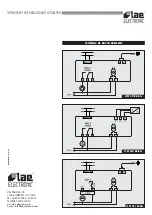
CAUTION
: when changing the display scale SCL, the parameters related to the absolute (SPL, SPH, 1SP) and differential (1HY, 1PB,
OS1) temperatures MUST be reconfigured.
TABLE 2
4. OPERATION DESCRIPTION
4.1. C
ONTROLLER STANDBY
. Parameter BAU determine the functions associated with the button
: with
BAU=NON
the button is
used to exit from the setup or to abort the autotuning routine; with
BAU=SBY
the button has an additional function, i.e. it can also be
used to switch on and off the controller: keeping this button pressed for about 3 seconds changes the controller status (on / stand-by).
When it’s on standby, the controller shows OFF, the output is off and it’s not possible to have access to the parameter setup.
4.2. T
YPE OF CONTROL
. The output may operate in the ON/OFF or PID mode:
1Y=HY
is fixed for ON/OFF control,
1Y=PID
for PID
control.
4.3. ON/OFF
CONTROL
. In the ON/OFF mode the output is ON or OFF in relation to the input temperature, set point
(1SP)
and
hysteresis value
(1HY)
. The hysteresis indicates the amplitude of deviation of the temperature from the set point in order to reactivate
the output. Increasing the hysteresis value decreases the switcheovers of the output, while decreasing the hysteresis value gives finer
control. For the output to operate in the heating mode, assign a negative value (see Figure 1) to
1HY
; assign a positive value for control
in the cooling mode (see Figure 2). With
1HY=0
the output is permanently cut out. After a switchover the output remains in the new
state for a minimum time of
1CT
seconds irrespective of the temperature value.
4.4. PID
CONTROL
. In the PID mode the output is ON for a fraction of the cycle time
1CT
. The cycle time characterises the dynamics
of the system to be controlled and influences the accuracy of the control: the higher the system speed of response the shorter the cycle
time to obtain greater temperature stability and less sensitivity to variations in load. Assign a negative value to
1PB
to make the output
operate in the heating mode (see Figure 3) and a positive value for control in the cooling mode. With
1PB=0
the output is permanently
cut out.
4.4.1. P
ROPORTIONAL CONTROL
. The temperature is controlled by varying the time of
activation of the output when the temperature is inside the proportional band (
1PB
).
The nearer the temperature to set point, the less time of activation. A small proportional
band increases the promptness of response of the system to temperature variations, but
tends to make it less stable. A purely proportional control stabilises the temperature
within the proportional band but does not cancel the deviation from the set point.
INSTRUCTIONS FOR INSTALLATION AND USE.
---
Internal self-test (3 seconds)
E1
In tuning: timeout 1error
5.4
Sensor T1 temperature
E2
In tuning: timeout 2 error
or
Over range or breakage T1
E3
In tuning: over range error
Tun / 5.4
Instrument in auto-tuning
OFF
Controller standby
1SP
1HY
Temp.
The output is on when
the temperature is lower
than the set point
plus hysteresis
Time
Output
The output in the heating mode switches off
when the temperature is higher than set point
on
off
Figure 1
ON/OFF control in heating mode
1SP
1HY
Temp.
The output is off when
the temperature is lower
than the set point
Time
Output
The output in the cooling mode switches on when
the temperature is higher than the set point plus hysteresis
on
off
Figure 2
ON/OFF control in cooling mode
1SP
1PB
Temperature
Overshoot
Steady-state error
Process
temperature
Time
Figure 3
Proportional Control (P) in heating mode


































